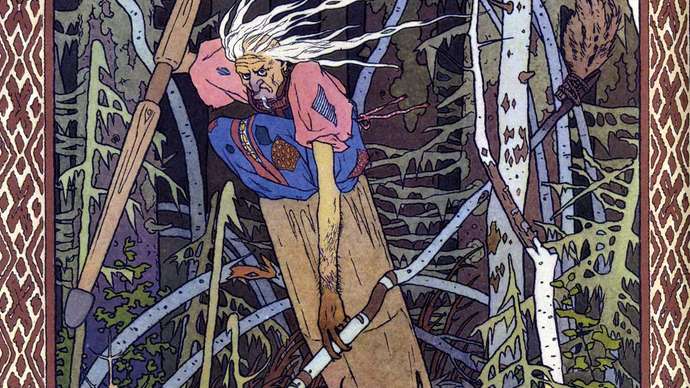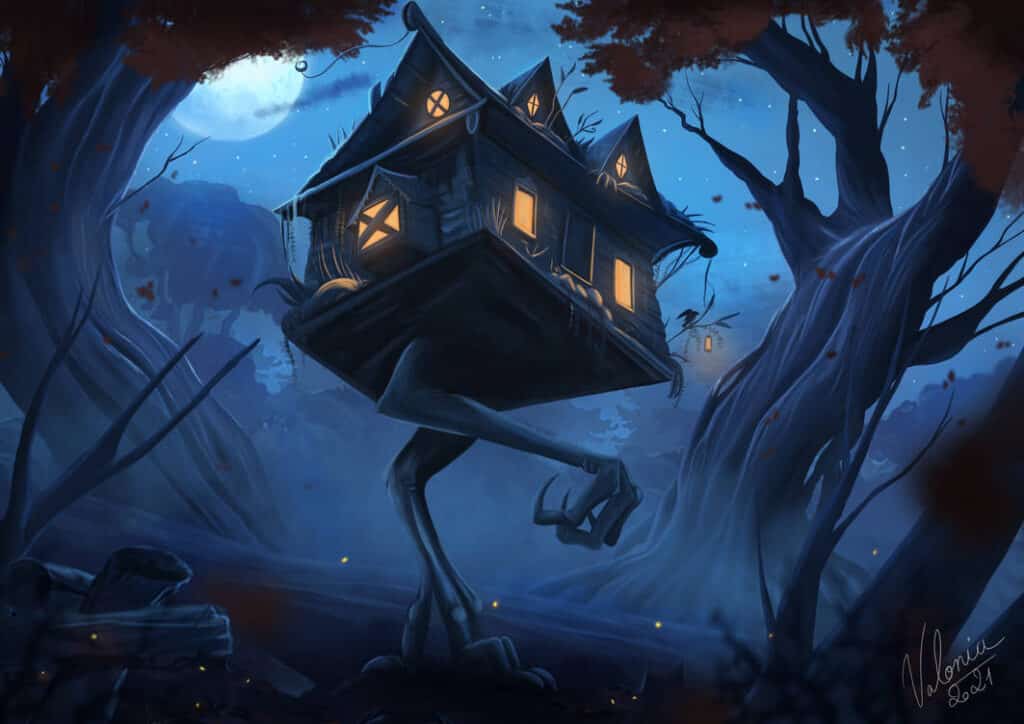The legendary Baba Yaga is an ambiguous creature. She is an anomaly, popularly described as a mother-nature figure and an evil creature who seeks to devour adventurers who fail the tasks she gives them.
Much like her unclear purpose, the meaning of her name is contested: it is widely believed that Baba means something akin to “elderly woman” or “grandmother,” whereas Yaga arouses many theories of meaning ranging from “serpentine,” “snake” and “wicked.” Ultimately, Baba Yaga is not a creature to be understood fully, only observed.

What is Baba Yaga?
Baba Yaga, in her most common artistic portrayal, appears as either a lone older woman, singular and driven by her desires, or a trio of old sisters, all of whom are depicted as incredibly thin, long pointed noses and teeth of iron which can rip through the flesh of all creatures.
Popularly, she rides around on a mortar instead of a broom (contrasting many ‘witch-like creatures in European folklore), donning a pestle as both a flying aid and a wand.
A majority of the stories and spun tales of Baba Yaga take place in her residence: a dilapidated hut. It is found deep in the woods, resting on chicken legs, with the head of a rooster on top. Per the legend, the fences which encase her home are made from the bones of human victims.

Inside her hut, adventurers often encounter her stretched over the kitchen stove. The stove is another common detail in tales of the Baba Yaga: often, punishment for her victims where they have failed her pertains to being cooked alive and eaten. Nevertheless, legend adorns Baba Yaga with the nickname “the bony one” despite her enormous appetite.
It is difficult to pinpoint her motives: she varies between acting as a patron and a villain, either helping the hero of the Slavic myth in their adventure/tasks or purposely disrupting them.
Her moral compass is clouded. While she doesn’t actively seek victims to eat or murder, it takes little to incite her violence – something as small as coming near her hut is enough. With that said, whatever promise she makes to the hero after he completes her quests, she keeps it wholeheartedly and never falters. Therefore, many of the stories stemming from the tale of Baba Yaga concern the heroes and heroines that have encountered her.
Vasilisa the Beautiful
In one story stemming from the legend of Baba Yaga, named “Vasilisa the Beautiful,” Vasilisa is a beautiful maiden, popularly compared to Cinderella – whose mother died and father remarried a nasty woman with daughters of her own.
When Vasilisa’s father embarks on a trip, the unkind stepmother sells their home and moves Vasilia and the three girls to a cottage deep in the woods, and proceeds to give the daughters impossible tasks to complete, aided only by the light of a candle.
When the lack of light becomes too burdensome, Vasilia seeks out better light in the woods – where she encounters Baba Yaga, who presents numerous laborious chores to Vasilisa, providing in exchange a roaring fire which Vasilia could bring back to the cottage. Vasilisa completes all the tasks.
In a skull lantern provided by Baba Yaga, the promised fire is lit, and she takes it home. Upon her return, the fire incinerates her horrible new family. While dark, when considering her misery in the stepmother’s hands – Vasilisa’s story ends on a good note, and later she even marries the tsar of Russia.
Baba Yaga acts both as an obstacle for Vasilisa as well as a savior. If Baba Yaga had not gifted her the lantern, Vasilisa might never have escaped her cruel stepmother and the horrid daughters. That said, how Baba Yaga frees her is violent and unforgivable. It was not for Vasilia to decide on the life or death of her new family.
A moral pillar to this story is the revelation of Vasilia as a violent, dangerous woman herself. Demonstrating contrasts with Cinderella and the magical godmother in its original story, Baba Yaga can be seen more similar to more to the evil stepmother who allows her daughter to cut off her foot so she will fit into the beautiful glass slipper.
The lengths to which Baba Yaga extends to free Vasilia are incredible: burning three humans alive and causing Vasilisa intense grief and regret before letting her leave the hut. The deaths, arguably, were unnecessary.
Baba Yaga and the Peasant Children
Our second-mentioned story, derived from the legend of Baba Yaga, involves a handful of peasant children, similarly detailing their suffering at the hands of a nasty stepmother.
In the tale, the children are sent to Baba Yaga to be killed, but they manage to escape the witch’s hut through the help of all the plants, animals, and other objects which Baba Yaga mistreats.
For example, a black cat helps them plan their escape because they feed him after a long stretch of malnourishment.
A wooden gate intervenes and blocks Baba Yaga from catching the children, for she let it rot and mold over.
The trees did the same for their own mistreatment.
After the children slip from her grasp, Baba Yaga soon gives up the pursuit. But, again, this tale ends well. The nasty stepmother is banished, and the father returns to protect his children, and again, Baba Yaga’s role is one of an obstacle. She would likely have been indifferent to the children if they hadn’t crossed her path.
Interestingly, while Baba Yaga stands as a synonym for Mother Nature, the natural world in this specific tale turns on her because of the suffering she has caused.
Still, she remains a mysterious individual and adds uncertainty to each of the tales she takes part in. Sometimes she takes the path of righteousness, and other times wreaks havoc and commits murder. Slavic literary discussion, therefore, is unclear on her true intentions to be good or evil.
Similar figures in Slavic folklore
Ježibaba is a creature that appears in Slavic folklore. Ježibaba and its variant creatures are directly related to Baba Yaga. The two figures most likely orignate from a common figure as far back as the medieval period, if not further, and both figures share confusing motives and unclear intentions when considering good and evil.
Scholars have noted a wide variety of creatures in Slavic folklore who share similarities with Baba Yaga. These similarities are no doubt borne of relations and cultural exchange between the Eastern Slavs and surrounding peoples. In Central and Eastern Europe, these creatures include the Bulgarian gorska maika (translating to Forest Mother), the Hungarian vasorrú bába (Iron-nose Midwife), and the Baba Roga (a tale used to scare children in Bosnia, Croatia, Montenegro, and Serbia.
Indeed, with Baba Yaga’s origin somewhat cloudy and her overall intentions as a mythical creature inconclusive, the stories stemming from this fascinating myth have enabled her to be cemented in legend.
If you liked this article, you might also enjoy some similar topics:
- The Original Little Red Riding Hood is Darker Than you Think
- The True and Tragic Story of Pocahontas That Disney Wouldn’t Tell You
- The Gruesome Details That Disney left out of Snow White
- Hansel & Gretel: Not Exactly a Children’s Tale
- The Disturbing True Story of the Pied Piper of Hamelin
- Tulip Mania – The Story of One of History’s Worst Financial Bubbles - May 15, 2022
- The True Story of Rapunzel - February 22, 2022
- The Blue Fugates: A Kentucky Family Born with Blue Skin - August 17, 2021